#carrion plant
Text

Carry on, Carrion Jinglebell
#my oc#oc#ocs#original character#jinglebell#zee#my art#original art#venus fly trap#pitcher plant#carrion plant#mushroom
176 notes
·
View notes
Text

November 9, 2018
Desert Botanical Garden
Phoenix, AZ
2 notes
·
View notes
Video
n13_w1150 by Biodiversity Heritage Library
Via Flickr:
Bilderbuch für Kinder Weimar :Im Verlage des Landes-Industrie-Comptoirs,1798-1830. biodiversitylibrary.org/page/46148887
#Children's encyclopedias and dictionaries#Juvenile literature#Natural history#Pictorial works#Plants#Smithsonian Libraries#bhl:page=46148887#dc:identifier=https://biodiversitylibrary.org/page/46148887#flickr#Stapelia hirsuta#carrion plant#Mimosa chaste#bashful sense plant#Mimosa pudica#fetid stapelia#carrion flower#starfish flower#sensitive plant#sleepy plant#action plant#shameplant#touch-me-not#botanical illustration#scientific illustration
0 notes
Text
Carrion plant

#Carrion plant full
If you don’t have the mass you can return to the previous room and interact with the entrance pipe to get back to medium size. Once defeated you can smash the wood on the path to the left to access it. If needed there is a water pool in the right corner of the room. In this next room you need to defeat two flamethrower enemies. Go through the door there to reach a new portion of the level. Defeat the drones to gain access to the upper corner of the room. Head up the now open path to trigger a combat sequence with three drones. Pull this switch to open two gates, one near you and another in the upper corner of the entrance/pipe room. When we care for Carrion-flower, it is best to keep the temperature within 15 ~ 25 degrees and never lower than 10 degrees when growing.Head up the left-side of this room to reach a switch you can pull. Carrion-flower is not tolerant to drought and high temperature, so it has a high requirement for temperature. Summer light is strong, it is best to place the plants in a semi-cloudy and ventilated environment when farming, and the plants should be shaded appropriately when the light is strong to prevent the plants from being sunburned by strong light. When we care for Carrion-flower in spring and fall, they can be placed on balconies, windowsills, and other airy, well-lit areas. They do not require much water and are best kept in moist and dry soil. They like to grow in warm, dry, well-lit environments. After the completion of preparation, fertilizer can be scattered in the soil.Ĭarrion-flowers are native to southern Africa. When we care for Carrion-flower, the replaced soil can be mixed with peat soil, garden soil, river sand and perlite. The stem drying under the carrion-flowers can also be caused by soil deterioration. When we care for Carrion-flower, it is necessary to water the soil properly, and then it is best to transplant the plants to a half-shade and ventilated environment for cultivation, to prevent water evaporation too fast.Ĭarrion-flowers like to grow in loose, breathable, sandy soil with good drainage. When planted, the stems below the carrion-flowers dry out, possibly due to water shortage. The following are details of Carrion plant care for lower lower stems drying.Ĭarrion-flowers belong to the Apoplaceae family and are often grown as home potted plants. It is best to keep the soil moist and dry. Carrion-flowers like to grow in warm, dry, well-lit environments. When we care for Carrion-flower, replaced soil can be a mixture of leaf rot soil, Garden soil, river sand, and perlite.Ĭarrion-flower care for lower lower stems dryingĬarrion-flower lower stems may have dried out during breeding, and should be properly watered in the soil Carrion- Flower dry stems can also be the result of soil deterioration, which requires replanting. Carrion-flowers like to grow in soil with good air permeability and drainage. Therefore, it is necessary to change the soil for cultivation. If the soil for carrion-flower cultivation is not changed for a long time, the soil deterioration is not good for air permeability, which will also lead to the wilt of the stem of the plant. When we care for Carrion-flower, it is best to keep the temperature of carrion-flowers at 15-25 degrees Celsius in normal times and 15-20 degrees Celsius in winter. Frostbite will occur in plants when the temperature is lower than 15 degrees Celsius, and in severe cases, the stem will wither. Temperature careĬarrion-flowers are drought tolerant but not cold tolerant, and have high temperature requirements.
#Carrion plant full
When we care for Carrion-flower, carrion-flowers can be grown in full sunlight in spring and autumn and winter, but they should be shaded properly in summer because the light is strong. However, long-term exposure to strong light during cultivation will lead to the wilt of the stem. Light careĬarrion-flower is a Succulent plant with a high demand for light. When we care for Carrion plant, carrion-flowers can be watered as dry as possible. However, if the plant is in a state of water shortage for a long time during cultivation, it will lead to stalk wilting. Carrion-flower likes to grow in warm and dry environments, and has strong drought tolerance. Water careĬarrion-flower stem wilting during cultivation may be caused by lack of water. The following are details of Carrion plant care for stem wilting. Carrion-flowers are highly drought-tolerant and require little water, so they can be watered on a wet and dry basis. Soil care Carrion-flower care for lower lower stems drying Carrion-flower care for stem wiltingĬarrion-flower stem wilting may be caused by lack of water, excessive light, inappropriate temperature or soil deterioration, and corresponding measures should be taken according to different situations.

0 notes
Text
Carrion plant

#Carrion plant full#
Vertical concave grooves along the stem.Shortlisted for the 2018 TWS Wildlife Publication Awards in the edited book categoryĭecomposition and recycling of vertebrate remains have been understudied, hampered largely due to these processes being aesthetically challenging (e.g., smell and sight).
#Carrion plant full#
During the winter months and when grown in full sun, the stems will turn a reddish color.
Stem: Stem Color: Gray/Silver Green Red/Burgundy Stem Is Aromatic: No Stem Cross Section: Angular Stem Form: Straight Stem Description: The subquadrangular stems grow up to 8" tall and thick.
Leaves: Hairs Present: No Leaf Width: This odor attracts flies, which in turn lay their eggs on the flower.
Flowers: Flower Color: Purple/Lavender Red/Burgundy Flower Inflorescence: Solitary Flower Value To Gardener: Showy Flower Bloom Time: Fall Summer Flower Shape: Star Flower Petals: 4-5 petals/rays Flower Size: 3-6 inches Flower Description: Large 6", flat, maroon to purple, star-shaped flowers with a foul odor, similar to rotting meat.
The seeds have a thin outer margin and many hairs.
Fruit: Fruit Color: Brown/Copper Fruit Value To Gardener: Showy Fruit Type: Follicle Fruit Length:
Cultural Conditions: Light: Full sun (6 or more hours of direct sunlight a day) Partial Shade (Direct sunlight only part of the day, 2-6 hours) Soil Texture: Sand Soil pH: Neutral (6.0-8.0) Soil Drainage: Good Drainage Occasionally Dry Available Space To Plant: Less than 12 inches USDA Plant Hardiness Zone: 10b, 11b, 11a.
Whole Plant Traits: Plant Type: Ground Cover Houseplant Succulent Habit/Form: Clumping Dense Erect Mounding Growth Rate: Medium Maintenance: Medium Texture: Medium.
Play Value: Attractive Flowers Colorful Easy to Grow Textural Wildlife Food Source Small reptiles and birds feast on the flies. Life Cycle: Perennial Recommended Propagation Strategy: Seed Stem Cutting Country Or Region Of Origin: South Africa Wildlife Value: Flies pollinate the flowers which are also attractive to other pollinators.
Attributes: Genus: Stapelia Species: hirsuta Family: Apocynaceae Uses (Ethnobotany): Rock gardens, container, houseplant.
Tags: #showy flowers #houseplant #drought tolerant #low growing #perennials #succulent #frost tender #groundcover #dry soils tolerant #flies #malodorous #non-toxic for horses #non-toxic for dogs #non-toxic for cats #container plant #showy #perennial #container See this plant in the following landscape: Cultivars / Varieties: An infestation of insects can cause damage to the stems, which in turn can cause fungal issues. Insects, Diseases, and Other Plant Problems: Mealybugs are the major insect issue for this plant. This pollination results in twin seed horns that are very attractive. As the flower begins to fade, the hairs, color and surface take on the look of a decaying animal. They are attracted to the foul smell of the flowers, the smell much like that of rotting meat. Once rooting has begun, the plant can be placed in a sandy soil mixture and allowing for good drainage.įlies pollinate the flowers. When placed in the soil, there is a good chance of root rot occurring. When working by either method, leave the seed or cutting laying on the ground, don't cover with soil. Propagation can be done with both seeds and by cuttings. Place a layer of grit on the surface of the soil to prevent moisture from accumulating around the stems base. Clay pots are porous, which allows air and water to flow through the pot, which in turn will help prevent root rot and other diseases. Placing the delicate plants on a heated grow bench will help them make it through the colder winter months.įor a successful plant, use a gritty succulent soil mix as well as placing the plant in a clay pot with drainage holes. Winter temperatures should be kept above 50 degrees and the soil should be kept dry. Those varieties require careful watering during the growing season and no water applied during the winter months. Varieties that have slightly hairy stems and the more showy or unusual flowers may not be as easy to grow as varieties that do not have these traits. Some are easy to grow and others are more of a challenge. There are several varieties within the species. Starfish Flower is a succulent plant with fleshy square stems and large, hairy, star-shaped, maroon flowers. Hirsuta translates to hairy, which is used to describe the flowers. Phonetic Spelling sta-PEL-ee-uh her-SOO-tuh Descriptionĭiscovered by Johannes van Stapel, this plant gained its Latin name from his discovery.

0 notes
Text
Carrion plant

The corona holds the pollen-packs of the flower, as well as the ovaries where the seeds develop. In the giant carrion flower, the corona is about 12-20 mm tall, 13-15 mm broad, and dark purple. The corona structure varies enormously between different carrion flower species, and there even exists a lot of variation within each species. This is like a little flower in the middle of the big flower. In the centre of the flower is the structure known as the 'corona', or gynostegium. Towards the centre of the flower they join up into concentric rings. The squiggly ridges are darker in colour, reddish to purplish. The background colour of the flower ranges from pale yellowish, even almost cream, to brownish or reddish. The hairs are reddish to purplish and increase in length and density towards the centre of the flower. The upper surface of the flower is covered with thin squiggly ridges and short hairs. The flower is starfish-shaped with five petals (occasionally six or even more), the tips of which are long and thin. The bud opens to unveil the interior of the flower in all its glory. The outside of the petals are greenish to pinkish, with longitudinal ridges stretching along their backs towards the tips. The flower 'buds' are already very distinctive: large and inflated like a bladder, with the petals all joined together and extended forward into a lengthened, spirally twisted tip. The flowers are of course the surest giveaway. It results from overactive branching at the growing tips of the stems, causing the plant to develop as a convoluted mass rather than as tufts of finger-like stems. Because, compared to leaves, the stems have less of a surface area in relation to their volume, water evaporates from them much more slowly than it would from large, flat leaves.Ī strange form of growth that often occurs in cultivation is called a 'crest'. The stems store water, 'filling out' after adequate rains and then storing this water for use during drier periods. Indeed, the succulence of these plants is an adaptation to fairly dry conditions. They are prone to rotting in soils that are too moist. The root system is quite shallow, and the plants grow best in loose soil. Sometimes the inner portions die off, leaving a number of unconnected clumps of plants. Plants growing in harsh circumstances can be much smaller, with the stems less than 1.2 cm (1/2") thick and only about 10 cm (4") tall.īranching at ground level, the stems root wherever they touch the ground, and in this way the plant clumps can grow and spread outwards. They usually branch at ground level, with the tips of the stems curving upwards, forming clumps reaching a metre in width, with the erect tips of the stems reaching 30 cm (12") in height under optimal conditions. The finger-like stems are usually about 2.5 cm (1") in thickness. These pigments protect the plants against harsh sunlight and against drying out. They become green in spring and summer when supplied with adequate water, but in autumn and winter, or during long dry spells, they become brownish, reddish or purplish. The stems themselves now carry out this process, called photosynthesis. The leaves are reduced to soft and dry papery remnants only about a millimetre in length, at the tips of the tubercles, and have lost their function of producing food for the plant. The stems are succulent and soft, with a somewhat velvety texture from short 'hairs' all over it. Occasionally stems form that are five- or even six-angled. There are regularly-spaced 'teeth' or tubercles along the ridges forming each angle. These stems are four-angled, with a ridge or 'wing' on each angle with hollows or grooves between the wings. The above-ground portions of the plant consist of a number of fairly short, succulent, finger-like stems. This carrion flower can be easily recognised as being a member of the group, even when not in bloom. The species name, gigantea, simply means 'gigantic' and refers to the flowers rather than the plant itself. The genus name Stapelia was created by the great Swedish naturalist Carl von Linné, or Linnaeus, in 1737, after the Dutchman Johannes Bodaeus À Stapel, who had found related species in the old Cape Colony. This species was named and described by NE Brown in 1877. These insects are not eaten - as some people mistakenly assume - but are merely used as pollinators. It is very typical of the group in that these flowers emit a foul odour reminiscent of rotting meat, and thereby attract flies and bluebottles. It has the largest flowers in the group - up to 40 cm (16") in diameter this also makes it the largest flowered succulent plant species in the world. The giant carrion flower is only one of a large variety of carrion flower species, or Stapeliads.

0 notes
Text
Carrion plant

#CARRION PLANT DRIVER#
#CARRION PLANT SKIN#
If carrion beetles find a carcass and start breeding in it, they get rid of it in a few days, rather than the many weeks it would take when they are not breeding. Sheena and I wanted to focus exactly on the impact that the breeding cycle of carrion beetles has on soil organisms. And it may also have long term consequences on how entire ecosystems work, including the climate. This is actually very surprising, given the long term focus on the relationship between plants and soil. As we soon discovered, carrion beetles have profound effects on soil and soil is central to how an entire ecosystem works, meaning that the beetle is central to that ecosystem. We have little knowledge of how carrion beetles change the way nutrients are recycled or the effects they have on the animals and microbes living in the soil. A recent study in the US found that during spring and summer, up to 75% of all small mammal carcasses are secured by carrion beetles. They are often scavenged or eaten by predators and so removed from the system, to be returned as dung. Forensic scientists have also carefully studied the stages of decomposition of larger animals by insects and microbes.īut what happens to small mammals and birds has rarely been considered, despite being vastly more numerous. The recycling of nutrients into the soil from leaf litter and dung has been well studied. Plants could not grow well and we would have little food. With no life in soil, nutrients would move through the soil very slowly. This is essential to life on this planet. These organisms (bacteria, fungi, protists and tiny invertebrates) are responsible for breaking down dead organisms and controlling the cycling of chemical elements through ecosystems. These blind spots are important because more than a quarter of all Earth's biodiversity lives in soil. We discovered that the beetle may be playing a vital role in stabilizing soil biology, which is essential if the soil system is to act as a carbon sink and help reduce atmospheric carbon emissions.
#CARRION PLANT DRIVER#
It became clear that by looking at the impact of carrion beetles and a dead carcass on the underlying soil, we might reveal a new driver of ecosystem functioning. She hadn't considered how these antimicrobial secretions might have effects beyond the carcass and in the soil itself. Sheena's focus, meanwhile, had always been on the beetles. If carrion beetles were having a significant impact on the soil then this would represent a large blind spot in our understanding of it. In the last two decades we have started to appreciate how important soil and plants are to our life and to the climate. This was of great interest to me because people who study soil generally concentrate on how soil microbes interact with plants, rather than animals. The production of these substances only starts when parents find a carcass. She and her team have found that the beetle parents produce antimicrobial substances called lysozymes in their secretions. Soil microbes are microscopic forms of life (mostly bacteria and fungi) that live in soil. Carrion beetles have to contend with nematodes, tiny worms which climb up through the beetle's orifice, delivering a deadly bacteria that turns its insides into a nutritious soup that the nematodes can breed in.īut Sheena is particularly interested in how the beetles defend their babies and the carcass they are feeding on against soil microbes. For example, there's the " zombie fungi" that burrow into the brains of ants and manipulate their behavior, or hairworms that make their host leap into water just before the hairworm emerges. She studies how these beetles use their immune systems to defend themselves against parasites and diseases. Sheena and I had more in common than I initially thought. Carrion beetles and soil are similar in the way they sit at this interface between the living and the dead.
#CARRION PLANT SKIN#
But I see soil very differently: as a very thin, breathing skin of the planet, full of myriad different, beautiful forms of invisible life – an ecosystem that enables life to reform from death. Most people, including fellow biologists, basically see soil as a place of death – full of dead plants and animals, which eventually decompose into pieces. Over the next few months my feelings changed. I confess the thought of dead corpses stuffed with creepy crawlies was initially repellent to me (especially just after lunch) but back then I really didn't know much about the incredible biology of these beetles. The carrion beetles (also known as burying beetles or sexton beetles), which Sheena researches, are masters of death: they breed in the dead carcass of a mouse or a bird and, together with their larval brood, reduce it to bones and skin in a very short time.

0 notes
Note
I'm sure it's all lore that will be revealed in due time, but could you tell us about some of the side effects of consuming the celestial flesh?
I’m definitely not good at working linearly and slow at story plot reveal right now anyway, so happy to answer lol
Also, I wasn’t sure how to gage how much context this answer needed so sorry in advance for the long answer 😭. And cw for graphic descriptions of disease/body horror stuff.
Tl;dr Eating Yvishnir eventually caused evolutionary entropy that sometimes causes horrors.
It’s said that Yvishnir (the body not in the ocean) was a fallen star from long ago, before humanity and the fall of Tartarus(ocean body). The primordials, (Furies and sea dragons) were the ancient fish and birds that fed on Yvishnir in order to sustain their size and godhood and multiply on Earth as its continued keepers. They grew jealous over humanity’s progress and out of fear they buried Yvishnir so humans wouldn’t find it, and hid themselves away. That’s how part of the creation myth goes anyway. Then Tartarus fell and uncovered Yvishnir once again, drawing the primordials out and changing the sea.
So when I say ‘eating the flesh’, I mostly mean the Crux. At first, when Yvishnir was discovered and exposed to the atmosphere, it produced something called Crux which permeated the corpse and oozed from it as a liquid, thought to be a type of otherworldly bacterium or ichor to help it decompose. It caused a sort of explosion of hyper biodiversity/evolution, starting with plants. Here are some examples, mostly some fungi:
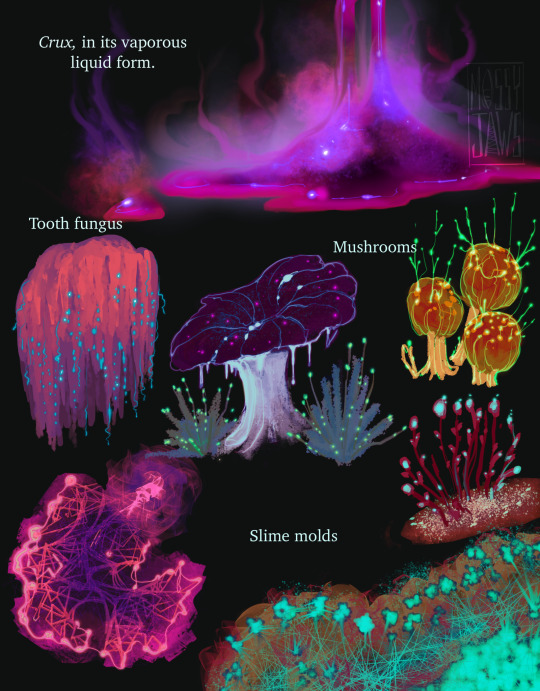
Most Humans didn’t really consider eating the Crux of course.
There were a few eccentrics and cults however that started the ball rolling. They would mostly eat it from fungi that had grown around Yvishnir, as well as cooking with it. This caused versions of human evolution, where they began to evolve into the Myce and other species to repopulate as, genetically merging with fungi in order to survive the new world. They’re under the blanket term ‘Hox Strays’, who make up most of Marrowtide and other known civilization islands to this day. There are different variations of these and their mutations have ‘stabilized’ over many generations but that’s another story.
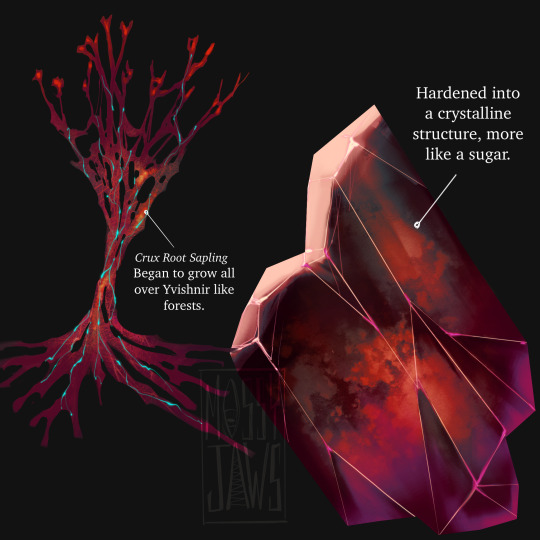
As for Yvishnir, there was a point where the Crux changed its properties, becoming more crystalline. Entropy took over the longer the body was exposed. Even the very insects that were feeding on it began to quickly horrifically mutate and grow. People would say that demons were being birthed from its rotted juices. The Crux began to bring on less desirable effects. Humans classified it as several new forms of horrific diseases ranging from otherworldly prions to the very DNA itself denaturing and mutating.
✨Some outcomes include but are not limited to;✨
>Victims known to have fits of uncontrollable laughter while bleeding from orifices. Several cysts that had broken out on the skin were found to contain bits of teeth, hair and even eyes, like they were growing them.
>Some victims became more beast-like but at the cost of their minds and insatiable hunger for more of the celestial flesh/Crux.
>Victims first described it as a tingling sensation in their chest and extremities. Their blood began to change its molecular structure to be crystalline as well. Cells became shard-like, until their blood eventually hardened completely. It could be seen poking through skin, like they were full of glass.
>Worse still, in a sort of sped up form of the first outcome, they can become a never ending cycle of constantly evolving body parts, growing biomass like cancerous tumors of body parts forever in bloom, eg. growing several hands from your eye or numerous organs. The body can’t sustain this and it pretty much ends in death.
These modern day effects were mostly observed by The Ladder and they determined that Yvishnir was not to be consumed by organisms any longer. In the modern day it is safely contained in Hearth, which is the name of the quarantined citadel outside of The Fever, serving god knows what purpose aside from genetic experiments they’re rumored to be continuing with the remaining crystalline Crux Root.
The primordials felt that those who continued eating the Crux were forsaken, punished for eating the god. They along with others had migrated far, far away at that point, populating the mountains of Zenith and oceans that no one dared to sail through. The body of Yvishnir faded into legends. Even people living within Fever and the isles surrounding it knew less and less about the body as time went on, more focused on surviving day to day.
Their are cases where people have somehow managed to preserve the liquid form of Crux, said to still be procured and preserved when the body was first uncovered and would thus have the least amount of risk involved.
Some people hunt mermaids for the soul purpose of searching the contents of their stomach, to see if they have remnants of Tartarus in them.
With Tartarus it’s all based on theory because no one is able to get down there to see wtf is going on, they only see the results.
#idk why I instinctively apologize for long answers#lotsa new info ig#I want to make more plants and stuff but I’m usually focused on characters#anon reply#lore#hallowed carrion lore#the celestial bodies
57 notes
·
View notes
Text

@thedenofravenpuff you are correct!
Though he doesn't hunt animals (heck even bugs he'll only eat if they happen to be in very close proximity to him) but he will scavenge any corpses he happens across if he's hungry enough. Otherwise he'll bury them and plant a little seed (usually a tree one) in the mound
#questions and answers#thedenofravenpuff#fnaf jack o moon#he has a pretty slow metabolism so insects and plants are usually enough to sustain him for good periods of time#it would be around autumn that he'd be more likely to scavenge carrion#so he has plenty of energy stored for winter
22 notes
·
View notes
Photo

The central chamber of a carrion flower (Rafflesia sp.) in Malaysia
by Art
36 notes
·
View notes
Text

My mom’s Carrion Flower (stapelia) is blooming like crazy!
Despite what everything says they do not smell at all!
#gay#lgbt#queer#solarpunk#garden#indoor garden#indoor plants#flower#gardening#flowers#plant#plants#witch#container gardening#carrion flower#stapelia#houseplant
58 notes
·
View notes
Text
Yes, I would have plants that make "carrion flowers"....
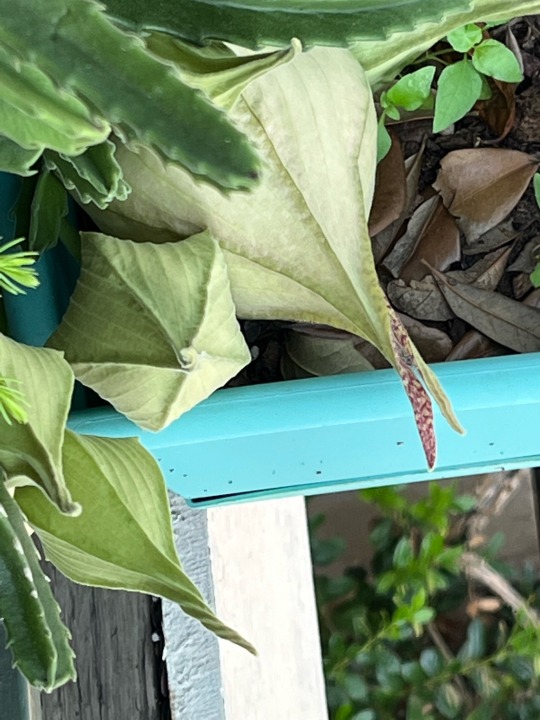
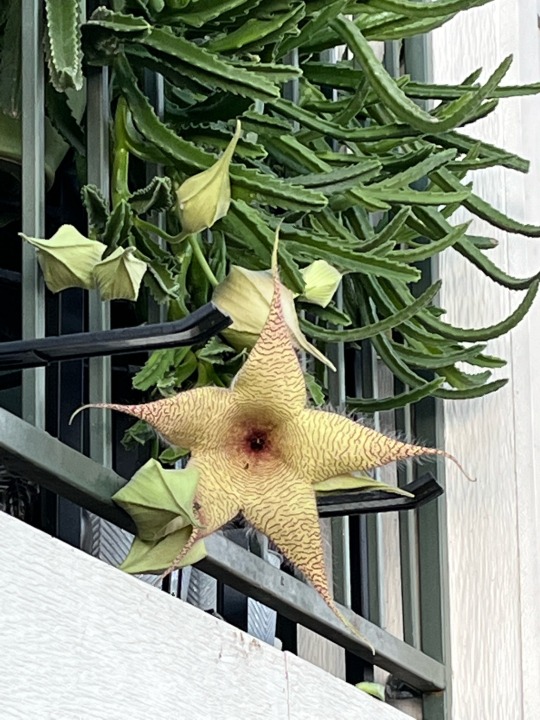
They smell slightly of rotting meat, and the hairs also help mimic the bodies of small carcasses. So, they attract flies to pollinate them!
And yes, the Demogorgon's head was designed to look like their flowers.



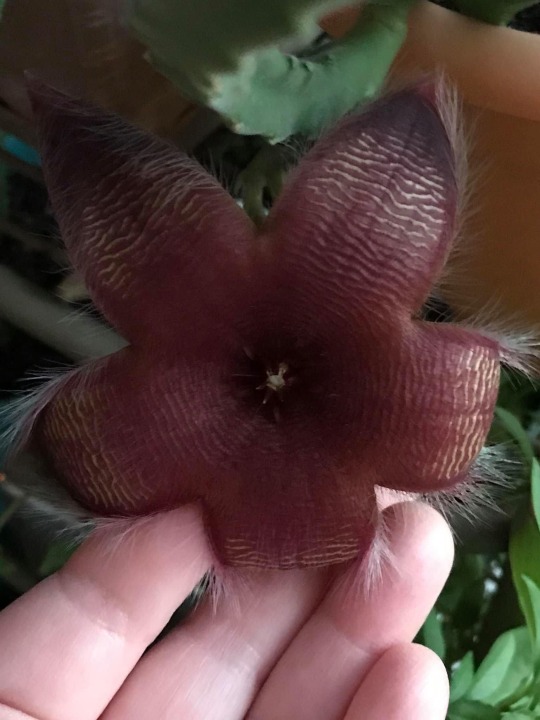
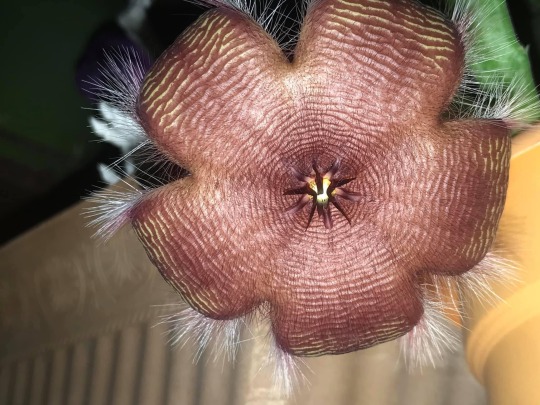

All of these pics are of my own plants. The darker, smaller ones, I named "Seymour". They could be Stapelia grandiflora, S. hirsuta, and/or S. asteria. All of those are kind of pink to burgundy with yellow striations... and all very hairy. The big one at the beginning is S. gigantea, and it definitely smells enough to immediately attract flies. I have (at least temporarily) named it "Gorgy".
This one I call "Audrey".


Seymour and Audrey flowers don't smell like much of anything to me.
But I freaking love them all!
#me in real life#me irl#my stuff#my plants#plants#gardening#stapelia#carrion flower#off topic#will delete this later#will save to off topic#sep 24 2022#stranger things#demogorgon
72 notes
·
View notes
Text



plantglyphister + sciplantglyphic + plantglyphisite
[IMAGE ID: three horizontal flags with nine stripes; each flag has the plant glyph in the center. the plant glyph is white with a soft, bright green outline. the middle stripe is twice as large as the rest of them, which are equally sized. the left flag has these top three colors: maroon, medium red, and light red. the middle flag has these top three colors: cool medium grey, dull seafoam green, and pastel blue-purple. the right flag has these top three colors: dull dark pink, medium grey-red, and light warm grey. each flag has these bottom six stripes: medium green, off-white, medium green, pastel green, light forest green, and medium forest green. END ID.]
plantglyphister: a gender connected to being a plant glyph monster; this gender is connected to the plant glyph, glyph magic, plant aesthetics, monster aesthetics, red-tinted forms of carricism, and nonbinary carrinhood!
sciplantglyphic: a gender connected to being a plant glyph scientist; this gender is connected to the plant glyph, glyph magic, plant aesthetics, scientist aesthetics, blue-tinted forms of carricism, and nonbinary carrinhood!
plantglyphisite: a gender connected to being a plant glyph parasite; this gender is connected to the plant glyph, glyph magic, plant aesthetics, parasite aesthetics, purple-tinted forms of carricism, and nonbinary carrinhood!
#plantglyphister#sciplantglyphic#plantglyphisite#monster system#scientist system#parasite system#plant glyph#carrin#carrion in nature#mogai gender#mogai coining#gender coining#tech.png
10 notes
·
View notes
Text






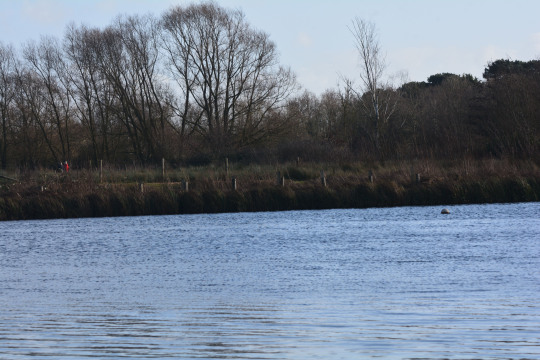



22/01/2024-Lakeside and home
Photos taken in this set are of; a rainbow out the back, camellia out the front, beautiful views at Lakeside including bright blue water, a dazzling Kingfisher which I was ecstatic to enjoy sensational views of in a tree with buds coming and flashing across the blue water some exceptional and powerful lunch time walk wild moments, cleavers, Magpie in a tree out the front I had a wonderful end to my lunch time walk seeing them and a Carrion Crow well out the front and a House Sparrow in the garden.
On a top list of birds seen on my walk intimate views of a gorgeous Goldcrest, Chaffinch, Great Tit, Robin, Magpie, Carrion Crow, Cormorant, Moorhen, Tufted Duck and Common Gull with Blue Tit heard were other highlights. I was also pleased to see two Stock Doves my first here for ages, a bird I'm on a good run for. Daisy, violet, mistletoe and rose hips were other Lakeside plant highlights. At home it was brilliant to see a Red Kite flying out my window today with Starling and lavender and rose hips enjoyed in the garden too.
#photography#kingfisher#cormorant#goldcrest#magpie#carrion crow#chaffinch#common gull#birdwatching#birding#lunch time#outdoors#monday#2024#home#lakeside#lakeside country park#daisy#flowers#plants#happy#walking#walk#january#europe#england#uk#eastleigh#hampshire#red kite
4 notes
·
View notes
Photo
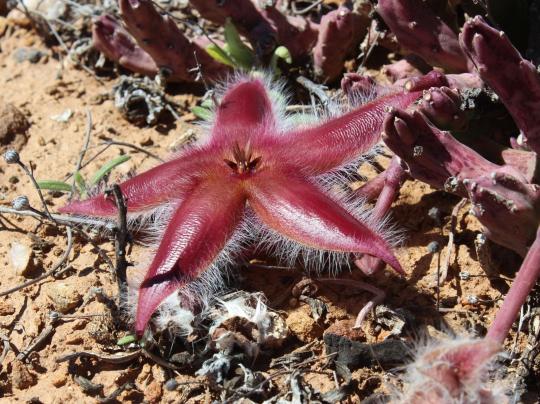
Carrion Flower (Stapelia hirsuta)
Family: Dogbane Family (Apocynaceae)
IUCN Conservation Status: Unassessed
While most flowering plants produce colourful, sweet-smelling, often nectar-secreting flowers to attract sugar-loving pollinators, the Carrion Flower and its relatives in the genus Stapelia produce hairy, “meaty-red” flowers that are said to smell like rotting flesh. The colour, hairs and smell of these flowers attract species of flies that feed or lay their eggs on carrion, and as these flies often fall for the mimicry of multiple flowers in a single blooming season they serve as pollinators, carrying pollen from male flowers to female flowers and allowing for the production of fertilized seeds, which are attached to cottony parachute-like structures that allow them to be carried away from their parent by wind. Native to western South Africa and southeastern Namibia, Carrion Flowers inhabit dry, arid habitats and are often found growing in shade cast by larger plants, which limits their access to sunlight but slows the rate at which they lose water through evaporation. Lacking well-developed leaves, members of this species respire and carry out photosynthesis using several offshoots of their stem that resemble small cacti, each with a waxy outer surface that partially blocks their stomata to further limit water loss and numerous short spines (actually what remains of their leaves) lining their edges to deter grazing herbivores such as the Cape Grysbok (a small species of antelope endemic to South Africa.) Carrion Flowers bloom in the summer and early autumn/fall, and are monoecious (meaning that every individual plant produces both pollen-producing male flowers and pollen-receiving, seed-producing female flowers.) While humans rarely harvest this species due to its unpleasant smell, it is occasionally cultivated recreationally due to its interesting biology, and the smell of its flowers have reportedly seen some use as an appetite suppressant.
--------------------------------------------------------------------------
Image Source: https://www.inaturalist.org/taxa/366290-Stapelia-hirsuta
#Carrion Flower#Stapelia#NOT zoology this time#plant#plants#wildlife#biology#botany#African wildlife#big meaty flowers
17 notes
·
View notes
Text
so I was skimming some of the flavor text in the dnd cookbook justin got for christmas, and the intro to elven cuisine mentioned many elves having dietary restrictions like vegetarianism and veganism because of "their great respect for all life", and not to be too galaxy brained and/or maybe kind of a bitch but I really feel like a lot of elves and druids specifically aren't vegetarian, because they have a better than average respect and compassion for all life but they also have a better than average understanding that that includes plants
#nothing that's alive wants to be killed and eaten actually. sorry#I think having a mindful and respectful relationship to the ecosystem and your part in it makes more sense for compassion and ethics#than trying to draw lines around which living things' desires to live and be uninjured do or do not count enough to qualify for mercy#and in dnd where there are entire peoples whose magic allows them to talk to animals AND PLANTS#I really feel like you either have to make peace with being IN the food web rather than separate from it OR... starve to death#get really good at living solely on fruits and milk. or get real weird and feed on carrion only maybe#I dunno#this is about fantasy peoples mostly but it IS also about like...#it used to be an accepted scientific truth that animals didn't have thoughts and feelings at all#it's still widely believed (and increasingly disproven) that certain 'lesser' animals can't feel pain or fear#studies are beginning to suggest that plants may be able to communicate and have some kind of consciousness that's not very well understood#I dunno it's like... we have an instinct to distance ourselves from the things we eat for our own comfort but that distance is an illusion#nothing wants to get eaten but everything must eat#worldbuilding
9 notes
·
View notes
